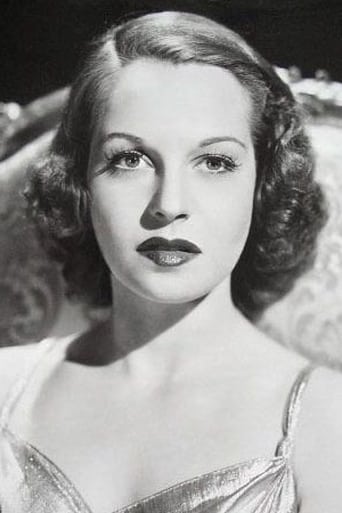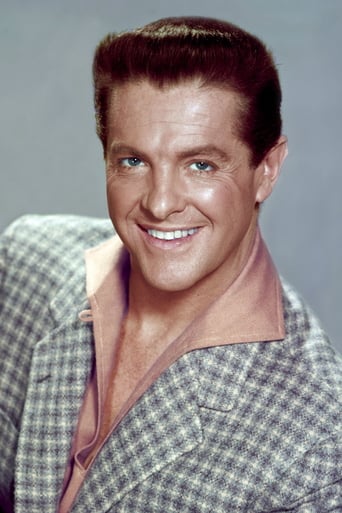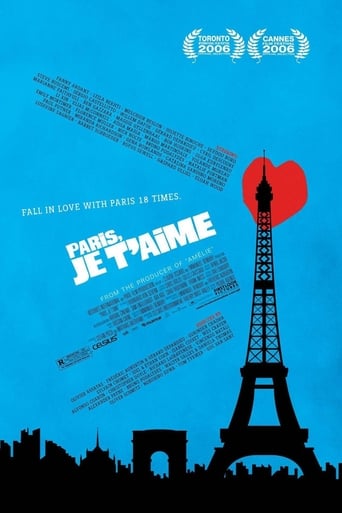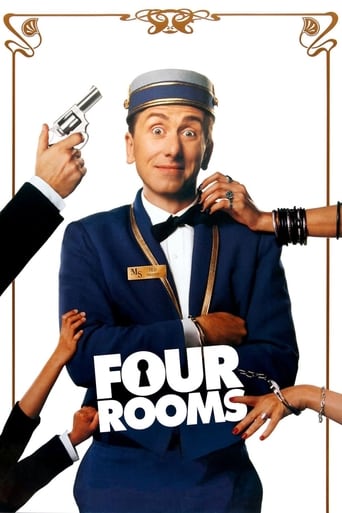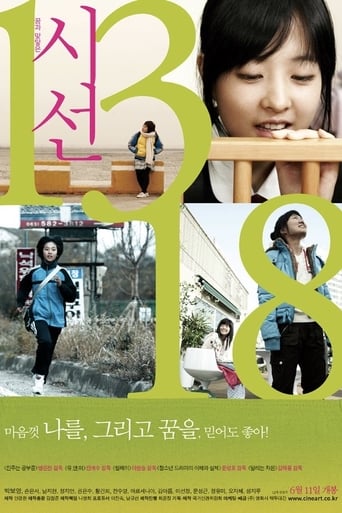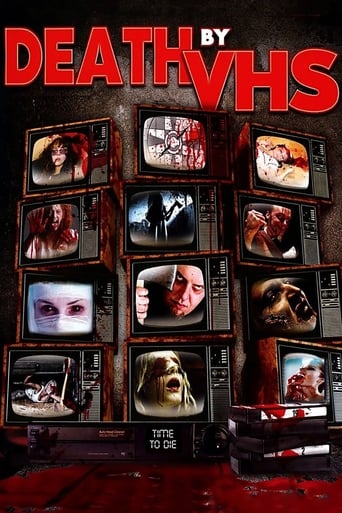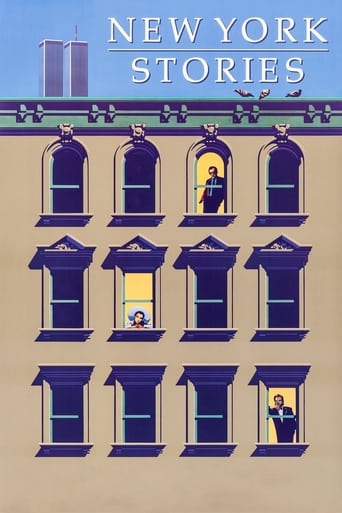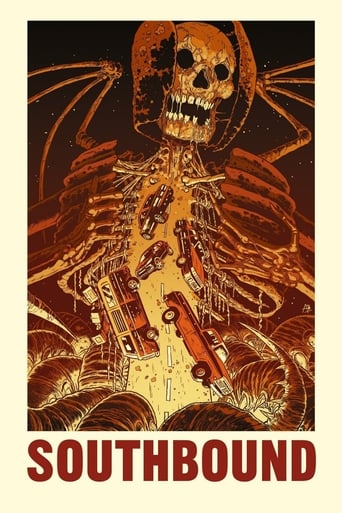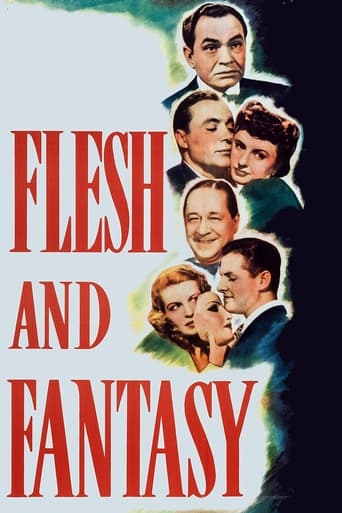
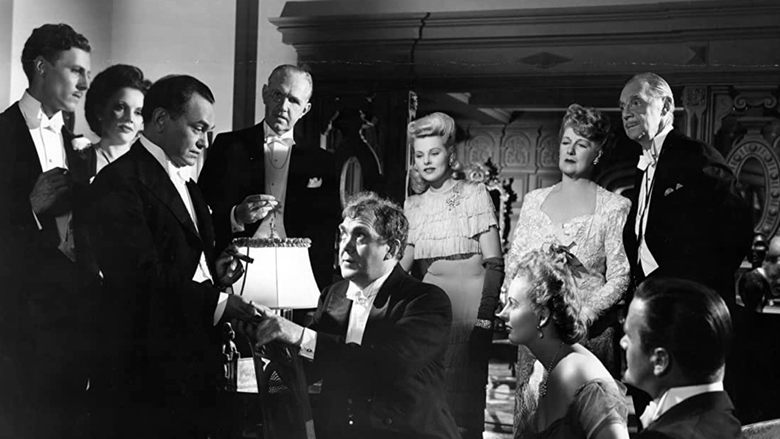
Flesh and Fantasy (1943)
Anthology film of three tales of the supernatural. The first story is set at the Mardi Gras in New Orleans. The second involves a psychic who predicts murder. The third is about a man who literally meets the girl of his dreams.
Watch Trailer
Cast


Similar titles
Reviews
Touches You
Just what I expected
Good concept, poorly executed.
Fresh and Exciting
Anthology film from Universal with three stories of the bizarre, as told through a framing story with David Hoffman and Robert Benchley. The first story is about a plain-looking woman (Betty Field) who wears a mask on Mardi Gras that is supposed to make her appear attractive to the man she loves (Robert Cummings). A beautifully photographed story with a somewhat flimsy premise. Good acting by Field and Cummings. The second story is about a fortune teller (Thomas Mitchell) who tells Marshal Tyler (Edward G. Robinson) that he will murder someone. Tyler becomes obsessed with the prediction which leads to a fairly predictable ending. Robinson is excellent as always. The third story is about a circus high-wire artist (Charles Boyer) who has premonitions about falling that involve a woman (Barbara Stanwyck). This is the weakest of the three stories. A fourth story was originally part of the film but Universal removed it. The following year they had a new screenwriter and director do additional material to add to the story, including a new happier ending. They released this as the movie "Destiny." Overall, not a bad movie but not a great one. Certainly it looks good. Director Julien Duvivier creates an ethereal atmosphere throughout.
Doakes (Robert Benchley) is read 3 stories to help in his decision as to whether or not to believe in fate or dreams.In the first story, its "Mardi Gras" and everyone is wearing masks and costumes. Henrietta (Betty Field), is depressed as she is ugly and is about to drown herself when a stranger (Edgar Barrier) appears. He leads her to a mask shop and tells her to pick a mask and join the festivities on condition that she return at midnight. She goes out and meets with Michael (Robert Cummings) who she has loved from afar for a considerable time. Wearing her mask, she enjoys a few hours with him before returning to the mask shop at midnight. However, Michael has followed her......In the second story, a palmist (Thomas Mitchell) is predicting events with astonishing accuracy at a soirée at the house of Lady Pamela (May Witty). Marshall (Edward G Robinson) sees that the palmist is not being honest with him and goes to his house to insist that he tells him the truth about what he can see. He warns Marshall that he will kill someone. The rest of the tale is played out with Marshall struggling with his conscience as he picks victims to kill.....In the third story, a tightrope-walker (Charles Boyer) has a dream that during his act he falls from the wire while staring at a woman (Barbara Stanwyck) that he has never met. The dream prompts him to cancel the dangerous part of his act. On his way over to America he meets the woman on the boat and they fall in love. He asks her to attend his next show which she does. What happens....?...........It is well-acted and I liked the first 2 stories in particular. The only dodgy part to the 1st tale is in believing that Henrietta is ugly - she just isn't! In the 2nd tale, Edward G Robinson is very good as he reconciles himself to his fate and delivers some funny lines along the way. There is also good support from the Dean (C Aubrey Smith). The 3rd story develops at a slower pace than the previous two and has an ambiguous ending.....Its a film that you remember once it has finished.
A charming "anthology" motion picture, of the kind that was briefly popular in the 1940s. This one contains three stories, each of a supernatural bent. None really brilliant, but diverting.The second piece was the best. This was based on a story by Oscar Wilde (not Noel Coward, as incorrectly stated in another review). Edward G. Robinson plays a lawyer haunted by a prediction that he will murder someone, and the always-watchable Thomas Mitchell is the palm-reader.The first, with Robert Cummings and Betty Field in a story set in the Mardi Gras, is appealing in a naive way. The third segment, set in a circus, is the weakest. Charles Boyer an acrobat? No way.This movie suffers somewhat from some of the most unconvincing studio-bound "locations" I have ever seen. I know, this was the 1940s and all that, made in the middle of the war, but puh-lease!
The inevitability of Fate and the mysterious movements of Destiny control our FLESH AND FANTASY.Director Julien Duvivier, in a follow-up to his previous TALES OF MANHATTAN (1942), crafted this new & intriguing sequential film. The emphasis, this time, is on the supernatural and precognition. In spite of the film's homilies about the ultimate power of personal responsibility, the movie is in reality about nothing more than providing some suspenseful entertainment for its audience.The three sequences are tied together by Robert Benchley, in his famous character of Doakes, who is shown the stories in a book at his men's club in an attempt to help him get over a case of the jitters.SEQUENCE ONE A bitter, unattractive seamstress (Betty Field) hopes a Mardi Gras mask will help her attract the affections of a young student (Robert Cummings). Edgar Barrier appears as the mysterious mask maker. Movie mavens will spot Marjorie Lord as a desperate client and Peter Lawford as an inquisitive Pierrot, both unbilled.The most intriguing moments in this sequence happens in the first few seconds, when demons are shown pulling a corpse out of the water, and in the last few, when the viewer sees what is in the mask shop window. Mr. Barrier's voice, honed by years of stage and radio experience, is put to good effect.SEQUENCE TWO A London lawyer (Edward G. Robinson) is told by a celebrated palmist (Thomas Mitchell) that he will commit a murder. Anna Lee appears as Robinson's fiancée; Dame May Whitty as her gossipy godmother. Wonderful Sir C. Aubrey Smith makes the most of his short role as a saintly cleric. Doris Lloyd plays a grieved widow, and Ian Wolfe a librarian, both uncredited.Based on a short story by Oscar Wilde, this is the film's most compelling episode. The acting is especially good, with Robinson topnotch and Mitchell turning in a canny performance. The special effects, in which Robinson discourses with his own reflection, are executed very nicely. Notice the mistake in the credits when they refer to Sir C. Aubrey Smith's character as the Dean of Chichester rather than the Dean of Norwalk.SEQUENCE THREE A circus aerialist (Charles Boyer) has a frightening dream in which he sees a beautiful woman (Barbara Stanwyck)-- and then he meets her. Charles Winninger plays the concerned owner of the circus. Clarence Muse appears unbilled as Boyer's attendant.The story is slightly silly, but the stars make a fine effort and the high wire scenes, using a double, are indeed suspenseful.



